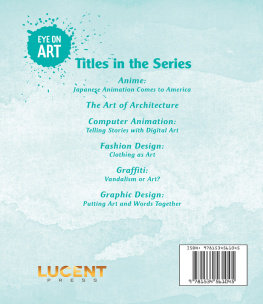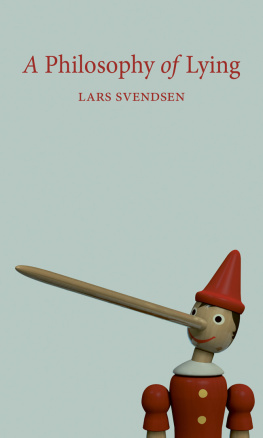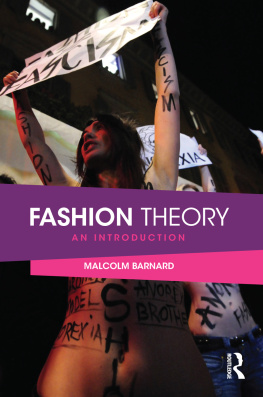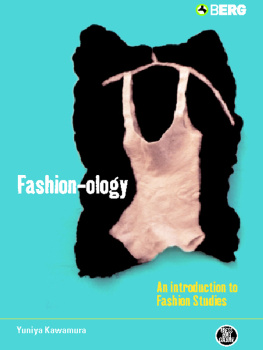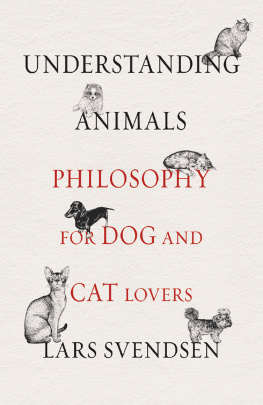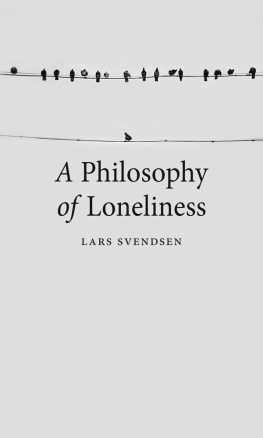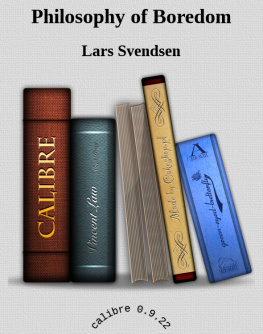Fashion:
A Philosophy
Lars Svendsen
Translated by John Irons

REAKTION BOOKS
Published by Reaktion Books Ltd
33 Great Sutton Street
London EC1V ODX
www.reaktionbooks.co.uk
First published in English 2006
This book was first published in 2004 by Universitetsforlaget, Oslo, under the title Mote: Et Filosofisk Essay by Lars Fr. H. Svendsen
Copyright Universitets Forlaget
English-language translation Reaktion Books 2006
This translation has been published with the financial support of
NORLA Non-fiction.
English translation by John Irons
All rights reserved
No part of this publication may be reproduced, stored in a retrieval system, or transmitted, in any form or by any means, electronic, mechanical, photocopying, recording or otherwise, without the prior permission of the publishers.
Page references in the Photo Acknowledgements and Index match the printed edition of this book.
Printed and bound in Great Britain
by Cromwell Press, Trowbridge, Wiltshire
British Library Cataloguing in Publication Data
Svendsen, Lars
Fashion: a philosophy
1. Fashion Philosophy
I. Title
391.001
ISBN-13: 9 781 86189 291 1
ISBN-10: 1 86189 291 8
Contents
Preface
Fashion has been one of the most influential phenomena in Western civilization since the Renaissance. It has conquered an increasing number of modern mans fields of activity and has become almost second nature to us. So an understanding of fashion ought to contribute to an understanding of ourselves and the way we act. Despite this, fashion has been virtually ignored by philosophers, possibly because it was thought that this, the most superficial of all phenomena, could hardly be a worthy object of study for so profound a discipline as philosophy. But if philosophy is to be a discipline that contributes to our self-understanding, and if fashion really has been and is as influential as I claim, it ought to be taken seriously as an object of philosophical investigation.
This book has had a long, but not difficult, birth, and much has changed en route. Innumerable approaches have been attempted, only to be abandoned because they proved to be blind alleys. And the final book is not what I had originally planned. It has become, not least, a more critical book than I had initially envisaged, since the subject matter forced me to adopt an increasingly critical perspective. I first began to think about writing a book on fashion five years ago, when I wrote A Philosophy of Boredom. In that book there was only enough space to touch briefly on the subject. The following year I published Art, in which the prime focus was the aestheticization of our world and fashion is naturally an important phenomenon in that context. I felt that both books left a number of loose ends that ought to be tied together in a book on fashion. In the years that followed I gave a number of lectures on fashion, but the book I was going to write kept getting pushed aside by other assignments. Now it has finally been written.
My thanks to Ellen-Marie Forsberg, Anne Granberg, Helge Jordheim, Ingrid Sande Larsen, Thomas Sevenius Nilsen, Erik Thorstensen, Ingrid Ugelvik and Knut Olav m#x00E5;s for their comments on the text. All instances of negligence, imprecision and errors still remaining are of course my sole responsibility.
1
Introduction: A Philosophy of Fashion?
Whatsoever sensibly exists, whatsoever represents Spirit to Spirit, is properly a Clothing, a suit or Raiment, put on for a season, and to be laid off. Thus in this one pregnant subject of CLOTHES , rightly understood, is included all that men have thought, dreamed, done, and been: the whole external Universe and what it holds is but Clothing; and the essence of all Science lies in the PHILOSOPHY OF CLOTHES .
Thomas Carlyle
Whats with the glasses? she asks.
Reef says its fashionable to look like an intellectual
this season.
Bret Easton Ellis
As early as the fifteenth century fashion was considered so important in France that Charles VII was asked to establish a separate ministry of fashion. Even though few would plead for such an institution nowadays, fashion has definitely not diminished in importance. Since the eighteenth century it has been increasingly democratized in the sense that it is no longer the sole preserve of a small group of affluent people. Hardly any present-day Westerner lies outside its domain. News-agents shelves overflow with fashion magazines, printed in bright colours on glossy paper, and fashion material fills innumerable pages of lifestyle periodicals and daily newspapers. The major fashion shows in Paris, Milan, New York and London are covered even on national TV news broadcasts. Fashion is clearly seen as important enough to warrant such a lavish degree of attention or maybe the converse is true, maybe it is all the attention that makes fashion important. Fashion is directed at both sexes and we would seem to have abandoned the view, previously widespread, that only women are obsessed with fashion. Increasingly both young and old are pulled into its orbit. And if we widen our gaze from the realm of clothes and consider fashion as a phenomenon that encroaches on all other areas of consumption, and that its logic also encroaches on the areas of art, politics and science, it is clear that we are talking about a phenomenon that lies near the centre of the modern world.
Fashion affects the attitude of most people towards both themselves and others, though many would deny it. The denial, however, is normally contradicted by our own consumption habits and as such it is a phenomenon that ought to be central to our attempts to understand ourselves in our historical situation. The emergence of fashion as a historical phenomenon shares a main characteristic with modernism: the break with tradition and an unceasing endeavour to reach the new. Fashion, as Walter Benjamin wrote, is the eternal recurrence of the new. I would go so far as to claim that an understanding of fashion is necessary in order to gain an adequate understanding of the modern world, even though it is definitely not being asserted that fashion is the universal key that is solely capable of providing such an understanding.
At the same time, fashion would seem to be one of the least important things one could imagine. In many contexts using the prefix fashion, as in fashion philosophy, is synonymous with dismissing it as something that lacks substance and gravity. From the very outset fashion has had its critics. There are texts from the fourteenth century that describe how ridiculous people look when they don attire that diverges from what is strictly functional. Right up until the 1980s serious studies of fashion had a tendency to express moral condemnation, maybe even contempt, for their subject matter. All this has changed, however, over the past couple of decades. This book is mostly critical of fashion, but it does not condemn it. A central ambition is to establish a more reflective relationship to fashion and as such to change our attitude towards it. This will not completely liberate us from fashion, but we can achieve a relative degree of independence from it.
This is not a history of fashion, even though the book will draw heavily on its history. Nor is it a normative aesthetical investigation in the sense that I intend to assess the aesthetic value of various fashions. The aim of the book is more descriptive than normative within the area of aesthetics. Generally speaking, it is the question of fashions relevance for the formation of identity that has preoccupied me in this investigation, although fashion can of course be analysed from many different angles. Since this is a philosophical investigation, I intend to concern myself more with the
Next page

